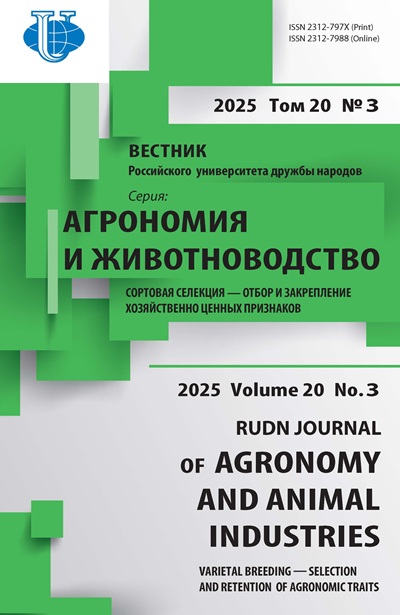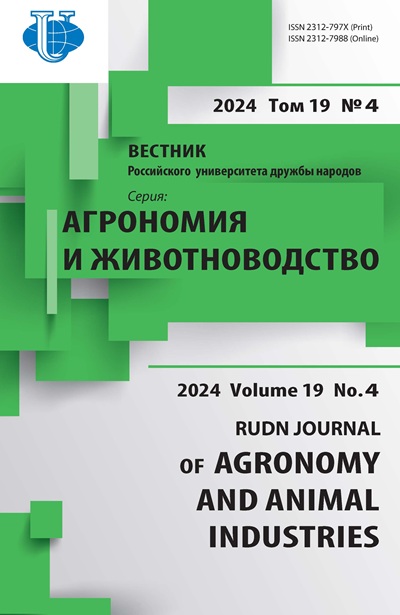Using natural product to reduce stress effects of herbicides in the Amur region
- Authors: Gretchenko A.E.1, Mikhailova M.P.1
-
Affiliations:
- Russian Research Institute of Soybean
- Issue: Vol 19, No 4 (2024)
- Pages: 566-577
- Section: Crop production
- URL: https://agrojournal.rudn.ru/agronomy/article/view/20124
- DOI: https://doi.org/10.22363/2312-797X-2024-19-4-566-577
- EDN: https://elibrary.ru/AIGNMK
- ID: 20124
Cite item
Full Text
Abstract
The effect of herbicides (active ingredients — cycloxydim and bentazone) and a natural product (based on seaweed extract) on the biochemical composition of soybean seeds and the productivity of the plants were investigated. Seeds and plants of mid-season soybean cv. ‘Nevesta’ developed by Russian Research Institute of Soybean were studied. The experiments were conducted on the experimental field of Russian Research Institute of Soybean, Sadovoe village (Tambov District, Amur Region) in 2021–2023. The test plot was 11.25 m2, there were four replicates, the arrangement of samples was randomized. The treatment of soybean crops was carried out in the phase of first triple leaf with herbicides: Bison (a. i. — bentazone) at a dose of 1.5 L/ha and Stratos Ultra (a. i. — cycloxydim) at a dose of 1 L/ha; and BioAlgo bioproduct at a dose of 5 ml/ha. It was found that the combined use of BioAlgo and herbicides had a positive effect on formation of soybean plant productivity. The survival rate increased by 3 % in the variant where vegetative plants were treated with herbicides and bioproduct compared to the control, and by 6 % — compared to herbicidal treatment. The number of beans per plant increased by 3.8 beans (LSD05 = 3.4), number of seeds per plant increased by 10.1 seeds (LSD05 = 7.2) and seed weight per plant increased by 1.66 g (LSD05 = 1.33) in the variant with the treatment of vegetative plants compared with the control. At the same time, soybean yield in the variants ranged from 2.15 (treatment of vegetative plants with herbicides) and 2.79 t/ha (treatment of vegetative plants with bioproduct and herbicides), in the control this indicator was 2.10 t/ha. The content of total protein and fat in ‘Nevesta’ soybean seeds increased by 2.32 and 1.07 %, respectively, compared to the control.
Keywords
Full Text
Table 1
Meteorological data for the soybean growing season in 2021–2023
Month | Average daily air temperature, °C | Amount of precipitation, mm | ||||||
2021 | 2022 | 2023 | Average | 2021 | 2022 | 2023 | Average | |
May | 11.9 | 11.9 | 13.4 | 12.4 | 96.1 | 61.0 | 41.0 | 39.0 |
June | 20.2 | 19.5 | 18.7 | 18.8 | 57.1 | 100.0 | 79.0 | 85.0 |
July | 23.4 | 23.4 | 22.5 | 21.5 | 104.2 | 38.0 | 73.0 | 106.0 |
August | 18.8 | 18.8 | 20.3 | 19.2 | 194.2 | 121.0 | 194.0 | 103.0 |
September | 14.2 | 13.1 | 13.2 | 12.4 | 35.9 | 39.0 | 102.0 | 66.0 |
Source: created by A.E. Gretchenko, M.P. Mikhailova.
Table 2
Effect of bioproduct and herbicides application on amino acid composition of protein, %, in seeds of soybean cv. Nevesta
Treatment of | Total protein | including amino acids | ||||
seed | vegetative plants | Lysine | Histidine | Valin | Methyl histidine | |
Control (without treatment) | 36.88 ± 0.22 | 6.74 ± 0.11 | 5.99 ± 0.26 | 7.05 ± 0.49 | 1.99 ± 0.21 | |
Water | Stratos Ultra (1 L/ha) + | 38.37 ± 0.20 | 6.74 ± 0.11 | 5.74 ± 0.28 | 7.01 ± 0.56 | 1.92 ± 0.10 |
Water | Stratos Ultra (1 L/ha) + | 39.20 ± 0.42 | 6.68 ± 0.25 | 4.15 ± 0.42 | 6.86 ± 0.55 | 1.87 ± 0.20 |
Source: created by A.E. Gretchenko, M.P. Mikhailova.
Table 3
The effect of bioproduct and herbicides on quantitative and qualitative composition of fat, %, in seeds of soybean cv. Nevesta
Treatment | Fat | Unsaturated fatty acids | ||||
before sowing | of vegetative plants | Linolenic | Linoleum | Oleic acid | Stearic acid | |
Control (without treatment) | 18.42 ± 0.61 | 8.84 ± 0.19 | 51.46 ± 0.47 | 21.73 ± 0.66 | 3.25 ± 0.24 | |
Water | Stratos Ultra (1 L/ha) + Bison (1.5 L/ha) | 18.18 ± 0.42 | 9.17 ± 0.19 | 51.18 ± 0.12 | 21.57 ± 0.69 | 3.27 ± 0.17 |
Water | Stratos Ultra (1 L/ha) + Bison (1.5 L/ha) + | 19.25 ± 0.43 | 7.80 ± 0.36 | 51.46 ± 0.45 | 24.80 ± 0.50 | 3.23 ± 0.07 |
Source: created by A.E. Gretchenko, M.P. Mikhailova.
Table 4
The plant density and survival of ‘Nevesta’ soybean plants in 2021–2023
Variant | Seedling density, plants per m2 | Germination, % | Plant density before harvesting, | Survival, % | |
Control (no treatment) | 46.3 | 90.5 | 44.2 | 95.5 | |
Distilled water | Stratos Ultra (1 L/ha) + Bison (1.5 L/ha) | 47.8 | 91.0 | 44.6 | 93.3 |
Distilled water | Stratos Ultra (1 L/ha) + Bison (1.5 L/ha) + | 48.7 | 90.8 | 48.1 | 98.8 |
Source: created by A.E. Gretchenko, M.P. Mikhailova.
Table 5
Biometric indicators of ‘Nevesta’ soybean plants in 2021–2023
Variant | Number per plant | Seed weight per plant, g | ||
Seed treatment before sowing | Treatment of vegetative plants | beans | seeds | |
Control (no treatment) | 16.0 | 38.0 | 5.61 | |
Distilled water | Stratos Ultra (1 L/ha) + Bison (1.5 L/ha) | 15.9 | 37.3 | 5,60 |
Distilled water | Stratos Ultra (1 L/ha) + Bison (1.5 L/ha) + Bio-Algo (5 ml/L) | 19.8 | 48.1 | 7,27 |
LSD05 | 3.4 | 7.2 | 1.33 | |
Source: created by A.E. Gretchenko, M.P. Mikhailova.
Biological yield of soybean cv. Nevesta in 2021–2023, t/ha: 1 — control; 2 — herbicides (treatment of vegetative plants); 3 — herbicides + bioproduct (treatment of vegetative plants)
Source: created by A.E. Gretchenko, M.P. Mikhailova.
About the authors
Alina E. Gretchenko
Russian Research Institute of Soybean
Author for correspondence.
Email: gae@vniisoi.ru
ORCID iD: 0000-0003-3930-5672
SPIN-code: 3750-4348
Researcher, Laboratory of Plant Physiology and Biochemistry
19 Ignatievskoe Highway, Amur region, Blagoveshchensk, 675027, Russian FederationMaria P. Mikhailova
Russian Research Institute of Soybean
Email: mmp@vniisoi.ru
SPIN-code: 9142-3480
Senior Researcher, Laboratory of Plant Physiology and Biochemistry 19 Ignatievskoe Highway, Amur region, Blagoveshchensk, 675027, Russian Federation
References
- Koshkarova TS, Zeyliger AM, Zinchenko EV, Ermolaeva OS. Comparative analysis of early-maping soybean varieties under the conditions of the south of Russia. Advances in current natural sciences. 2022;(6):15—20. (In Russ). https://doi.org/10.17513/use.37835
- Levchenkova AN. Evaluation of the influence of various humic preparations on the growth and development of various agricultural crops. In: XI International scientific conference of young scientists. Velikie Luki; 2016. p.12—16. (In Russ).
- Orazaeva IV, Muravev AA. Productivity of soybean varieties depending on seed inoculation and nitrogen fertilizer. Achievements of science and technology in agro-industrial complex. 2018;32(4):34—37. (In Russ). doi: 10.24411/0235-2451-2018-10407
- Jumrani K, Bhatia VS. Interactive effect of temperature and water stress on physiological and biochemical processes in soybean. Physiol Mol Biol Plants. 2019;25:667—681. doi: 10.1007/s12298-019-00657-5
- Ivanenko AS, Sozonova AN. Economic and biological and selection value of early ripening soybean varieties in the forest-steppe zone of the Trans-Urals. Feeding of agricultural animals and feed production. 2020;(10):3—16. (In Russ.) doi: 10.33920/sel-05-2010-01
- Melnik AF, Kondrashin BS, Kirsanova EV. Soybean yield depending on the method of sowing and the timing of herbicide treatment. Bulletin of agrarian science. 2022;(5):114—118. (In Russ). doi: 10.17238/issn2587-666X.2022.5.114
- Kravtsova N, Boyko E, Volokhatykh A. Effectiveness of post-emergence herbicides in soybean crops. The scientific heritage. 2021;(77–2):9—11. (In Russ). doi: 10.24412/9215-0365-2021-77-2-9-11
- Sinegovskaya VT, Chepelev GP. Productivity of soybean crops depending on joint application of herbicides and biologically active substances in Priamurye. Far East agrarian herald. 2018;(2):44—51. (In Russ). doi: 10.24411/1999-6837-2018-12027
- Lysenko NN. Herbicides in soy crops. Bulletin of agrarian science. 2018;(2):19—28. (In Russ). doi: 10.15217/issn2587-666X.2018.2.19
- Gretchenko AE, Mikhailova MP, Serebrennikova YO. Formation of the productivity of soybean variety Zhuravushka using biological products and herbicides under the conditions of the Amur region. Achievements of science and technology in agro-industrial complex. 2023;37(6):55—60. (In Russ). doi: 10.53859/02352451_2023_37_6_55
- Syrmolot OV, Baidelyuk ES, Kocheva NS. The use of biological products and growth stimulants in the cultivation of soybean in the Primorsky territory. Achievements of science and technology in agro-industrial complex. 2020;34(8):70—74. (In Russ). doi: 10.24411/0235-2451-2020-10812
- Çiğ F, Erman M, Sonkurt M, Çiğ A. The role of beneficial microorganisms in the protection of plants growing in natural landscape areas. In: Efe R, Zencirkiran M, Wendt JA, Tumsavas Z, Unal H, Borisova B. (eds.) Current Trends in Science and Landscape Management. Sofija; 2017. pp. 427—443.
- Tikhonovich IA, Zavalin AA. Application potential of nitrogen-fixing and phytostimulating microorganisms for increasing the efficiency of the agroindustrial complex and improving the agroecological situation in Russian Federation. Plodorodie. 2016;(5):28—32. (In Russ).
- Minchenko ZN. The effectiveness of various microfertilizers in the cultivation of soybeans. Agrarian bulletin of the Urals. 2022;(9):22—32. (In Russ). doi: 10.32417/1997-4868-2022-224-09-22-32
- Kostjukov VV, Nakonechnaya IV, Kosheleva OV, Apolonina TM, Ivchenko VM, Shcherbakov NA, et al. Farm testing of non-insecticidal control of soybean and stevia pests in Krasnodar territory. Entomological Review. 2015;95:441—446. doi: 10.1134/S0013873815040053
Supplementary files
Source: created by A.E. Gretchenko, M.P. Mikhailova.
















